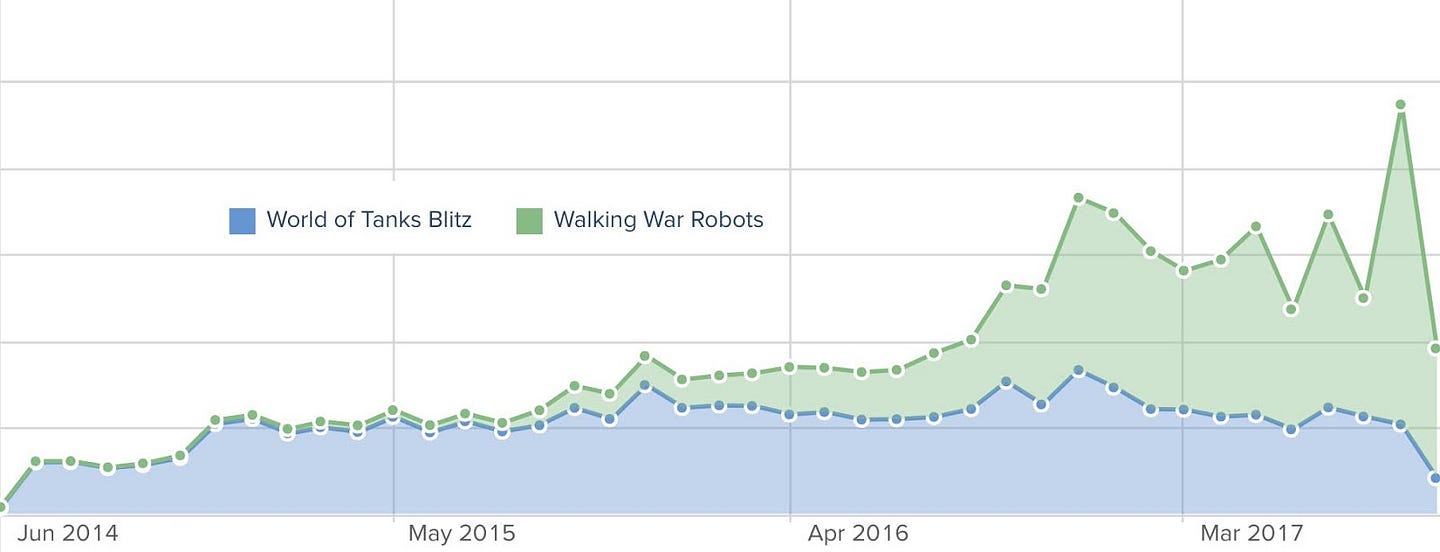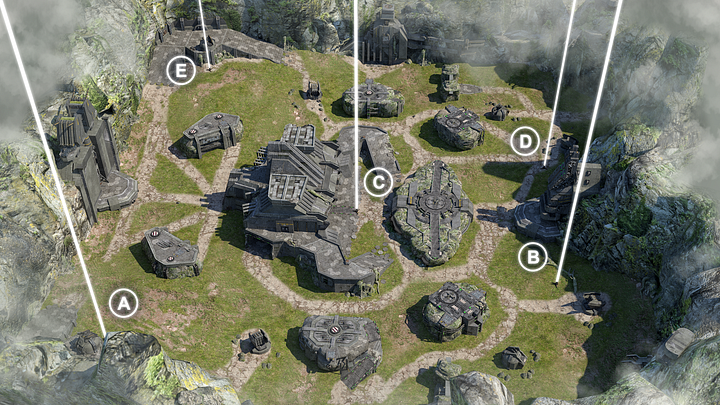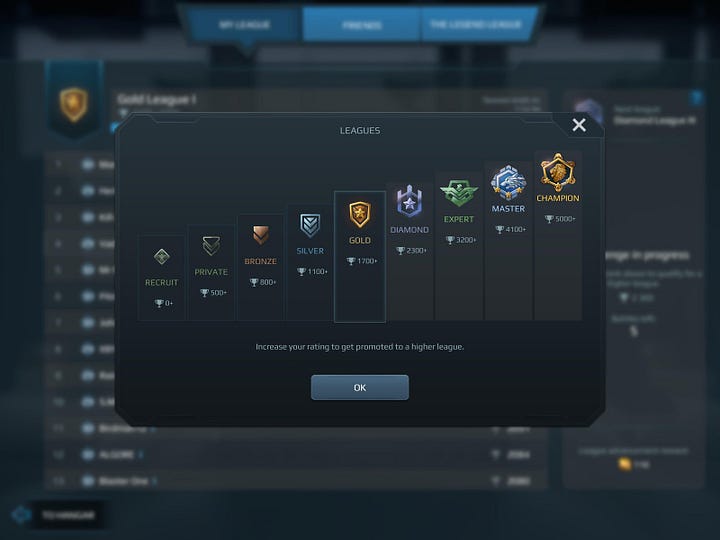War Robots is a free-to-play mobile game by Moscow developer Pixonic that was launched three years ago. In the game, you are fighting with giant, walking robots in 6v6 PVP matches controlling territory by capturing beacons, and, of course, by destroying other robots.
Last year was an outstanding year for War Robots. Revenue increased five-fold and exceeded $3.5 million per month. The number of installations was tripled and reached 50 million. DAU is about 800,000 players.
Why does War Robots attract players so much? Judging by its dynamics, War Robots is the only adequate game in the genre niche of slow shooters, which is dominated by World of Tanks (WoT). In a slow shooters game, exchanging of fire lasts longer than in the mainstream shooter games. It looks more realistic when long fights occur between combat vehicles with armor and survivability.
Slow shooter games forgive small mistakes. It makes them perfectly fitted for mobile touch controls as the loss of a second while fixing the aim on the screen is not critical. If you look at the bestselling lists of mobile platforms, we find that the only representatives of realistic multiplayer shooters at the top are World of Tanks Blitz and War Robots.
On the graph, we can see the comparison of worldwide revenue for the slow, realistic shooters in the last years. WoT Blitz and War Robots were launched simultaneously but evolved in different ways.
Before we start talking about War Robots, I want to tell you a story about my experience with the game that happened one year ago. That was a time when old systems of matchmaking based on vehicle and weapons tiers existed. I think you need to know about it because most of the current audience of the game passed through it. After more than 200 battles in War Robots in 2016, I had a 98% of victories in the last 50 battles, and I’m not a skilled player. But in War Robots, I got very offended if I suddenly lost a game after winning 40 in a row.
A high winning percentage is not a result of spending money. I paid only $15, a small amount by the standards of mobile f2p games. The secret of prosperity and victories was presented to me by the developers in the newcomer pack for $5 with the robot Gepard. This robot has a fixed speed of 58 km/h, which broke the matchmaking system.
Usually, the speed of robots upgrades gradually. However, in the case of Gepard, you didn't need to upgrade it to use its advantage and to stay on lesser tiers of matchmaking. In combination with the premium weapon – Magnum, I got an instant kill rapid nightmare.
Gepard players were cursed on social networks and forums every day. I played with Gepards and won 48 of 50 battles. I was shocked that a 98 win percentage is possible in modern MOBA. That was a great guilty pleasure experience. Every time I hoped that the game would somehow stop me, it did not occur until a total change of the matchmaking system had happened.
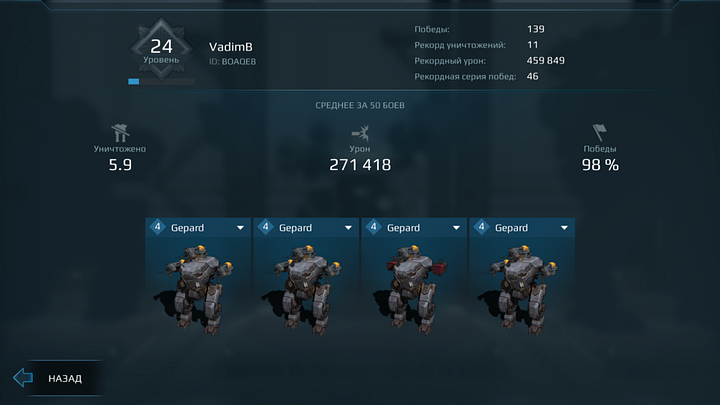
Is War Robots a pay-to-win game? In 2016, when I started to play the game, I would have said yes. But now it’s a question. Pay-to-win is not a shortcut to just mark a game as bad. Pay-to-win is how players perceive their journey in the game. It is clear that publishers want to make new content stronger than the old one to quickly sell it. But in games like War Robots with real-time PvP arena, this is the most traumatic player’s experience. Finding the balance between these mutually exclusive requirements is very difficult. Let’s see if it was possible to do it in War Robots.
GAMEPLAY
In War Robots, the player spends most of the time in battles. It’s the essential part of the game; that’s what the player comes back to the game for. So? We press the big orange button «To Battle» in the main menu, and begin on one of the game’s maps. The game offers you a robot to choose, and after the countdown, the battle starts.
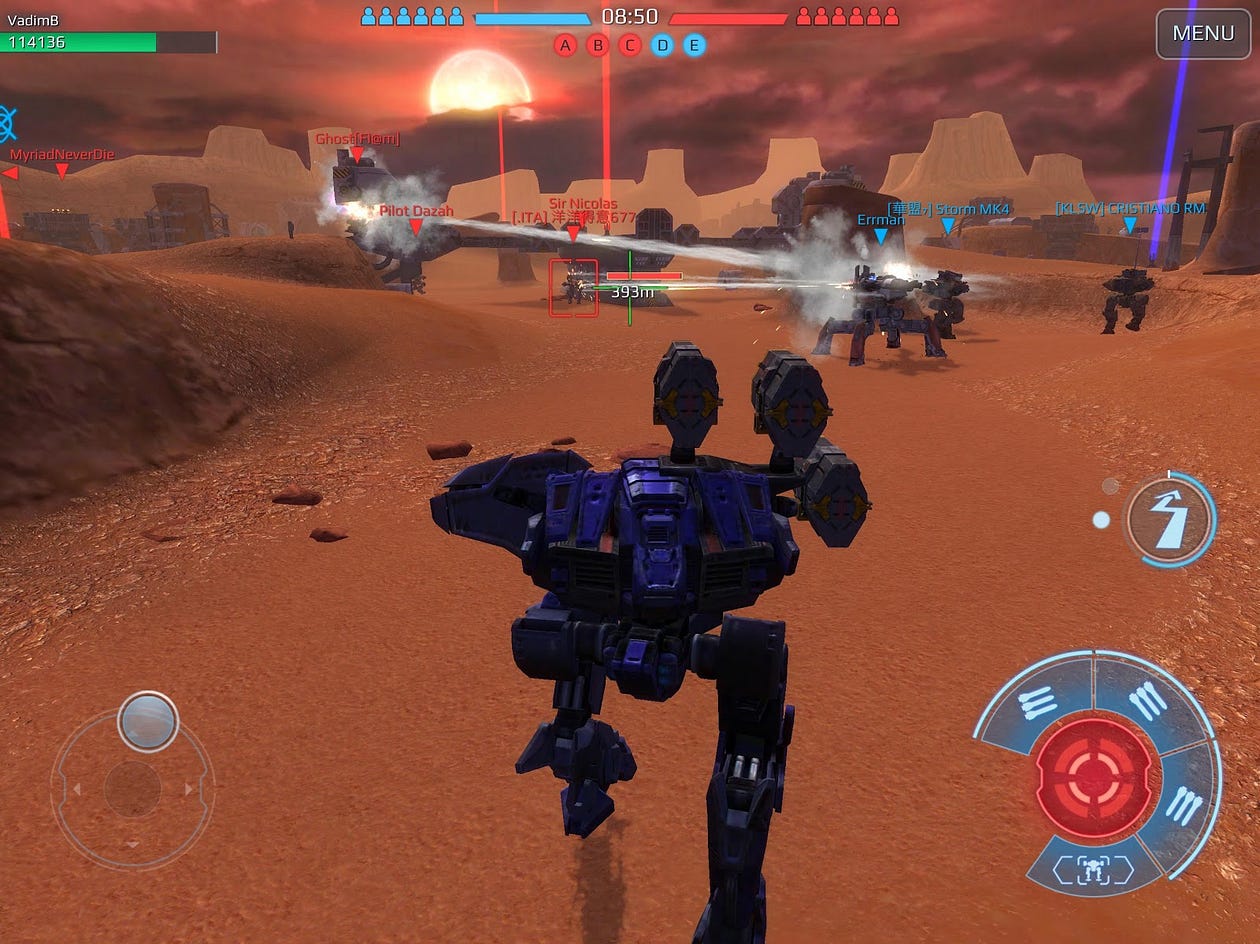
The most frequent choices are the robots with the long-ranged weapons – missiles or lasers. Game maps are a square kilometer per kilometer. There’s no fog from the war in the game, and enemy robots can immediately be captured with missile sights. You can already see what I mean the shooting starts right away. Players quickly crawl around the map under missile fire; they take cover; they engage in one-on-one battles, and they capture beacons.
Apart from the tactical skirmishes with robots in battle, there is a strategic part - control of lighthouses. There are five beacons on the map, and if one team controls three of them, then the opponent's point slider starts to melt. It’s hard to win by just killing robots. The player can have up to 5 slots with robots in the hangar, and after destroying one robot, they can only continue the game with another one.
There are two main game modes: Domination and Beacon Rush. In Domination, the robot appears at its base after being destroyed. In Beacon Rush, it might seem in any of the captured beacons. In the second mode, fights are faster and more violent. That’s why more skilled players prefer this mode.
Map Design
Maps in War Robots are mostly industrial landscapes or ruins. There’s only one map with downtown, but it looks pretty unnatural. Ironically, it is just on this map that we can see how big our robots are-the height of 5 floors.
The primary condition to win in this game is control of the beacons. That’s why it’s necessary to have the right design of the maps. I like the way Pixonic did their job! The maps look pretty natural, but at the same time, symmetrical. Most of the most active have "conservative" designs with the central beacon. To dominate in battle, you need control of 3 of 5 beacons. A team takes two beacons by laying near the place of disembarkation right away and having the main fight for the central beacon. On such a map, there is a classic turn of the plot – a sudden loss of “yours” beacon when all the power concentrates in the center of the map.
An essential characteristic of the maps is that they are divided into open and closed maps. On the public two, there’s a big chance to see robots with medium and long-range weapons. On the closed maps with lots of shelters and labyrinths, robots with melee weapons have the advantage. This way, the design of the maps encourages players to have guns of different types on their roster. This situation is not favorable for the players, so in response, Pixonic now makes new maps with unusual symmetry. On the Valley map, there are three beacons, including a central beacon placed close in the labyrinth of ruins, and two beacons placed by the edges of the map. This design allows robots with close and long ranged weapons to properly play together.
An example of the asymmetric Valley map that makes for a comfortable game for robots with close and long ranged weapons
Controls
For me, an easy way to play in action games is the most critical priority. War Robots took the simple way to play from GTA as a base. The left finger is responsible for legs while the right thumb is for body turns and for aiming. War Robots is very lucky because they made the game about human-like robots. Robots are managed very naturally and smoothly. During the fight, there is no additional thought about how to run in one direction and shoot at another. The player focuses merely on shooting.
The game nicely solved the problem with crosshairs. In mobile shooters, the aim tightly sticks to the enemy, or you’re trying to aim yourself. In War Robots, an excellent combination of these elements is realized. The aim continually tracks enemies using a red target box, showing valuable information about the distance to the target, and quickly becomes the focus of the goal. After the start of the shooting, the aim behaves very smoothly when you take it away from the opponent. Usually, this is enough to adjust the line of fire. For casual players who don’t like a hunt for pixels, there are many weapons with homing or widespread damage to the area.
Robots Setups & Matchmaking
To classify the variety of combat vehicles in the game, you need to start with the types of weapons. Armament is divided into heavy, medium and light. Types of weapons differ only in the magnitude of damage, not in range or kind of damage. Let’s give 3 points to the heavy weapon, 2 points to the middle, and 1 point to the light weapon. There are also special abilities (jump, dash, invisibility, etc.), and shields that are also estimated at 1 point.
The light robot is a platform with an average speed of 55 km/h, and a strength of 90,000 HP, which on average, an arm on an average of 3 points. The ordinary robot is a platform with an average speed of 40 km/h, and strength of 150,000 HP which is armed with an average of 5 points. With a massive robot, these figures will be 30 km/h 170.000 HP and 8 points.
Pixonic balances robots for the soft game currency primarily by increasing HP. Robots for hard currency are balanced with the addition of exciting special abilities.
There are 29 robots and 28 types of weapons in the game at the moment. Robots and weapons can four from 1 to 12 tiers. The variety of weapons that can be installed on the robots gives depth to the game.
Additionally, we can assemble different weapons for close or long-range combat. We can also make “crystal cannons” or walking fortresses. This is an inexhaustible subject for users that guide and dispute in social networks. So, how can you determine which robots can fight in one arena so that everyone has equal chances?
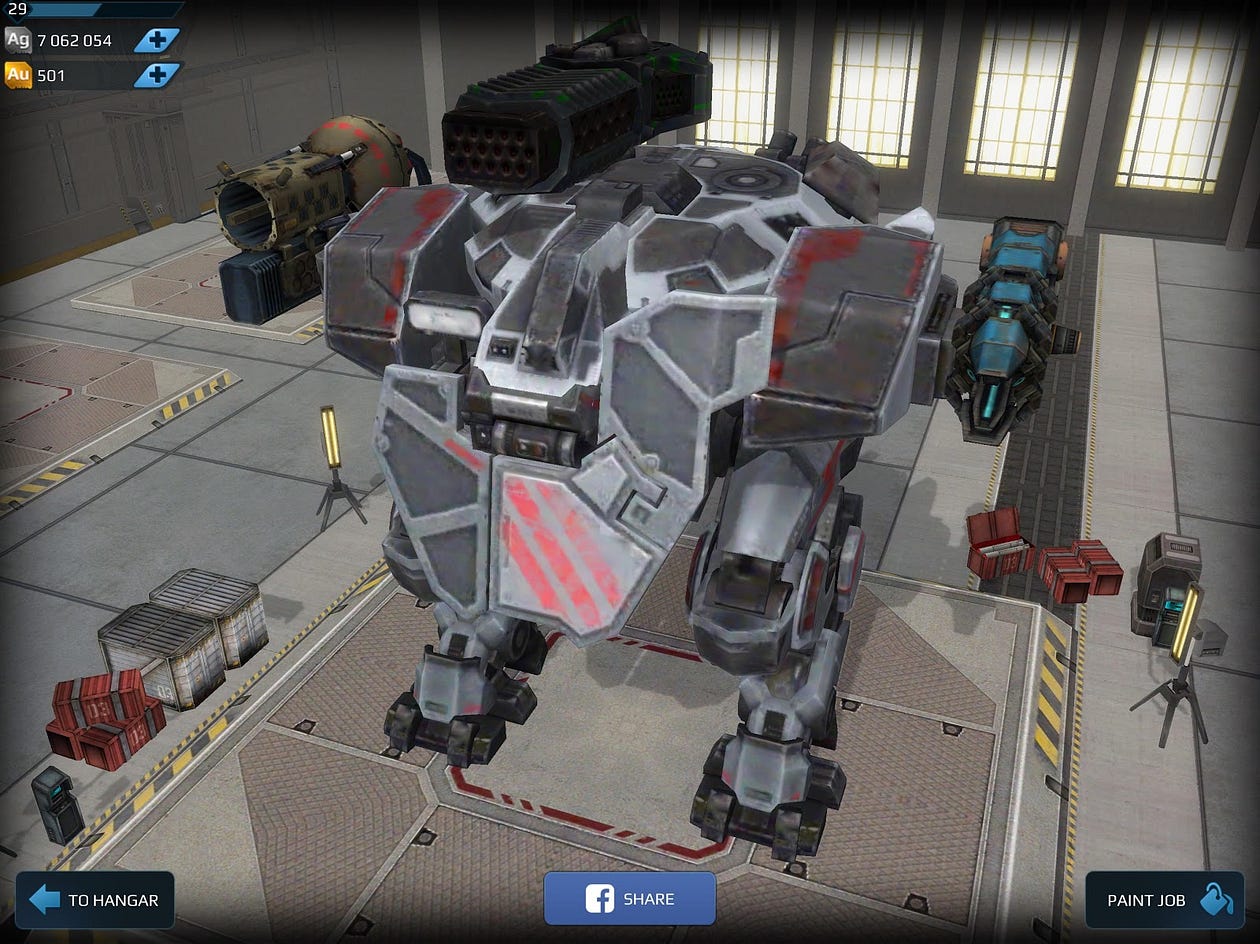
Since the release of War Robots, about the same system of matchmaking as in the World of Tanks Blitz efficient. Tanks enter +/-1 tier fight with the same number of light, medium and heavy vehicles in one battle. But in WoT Blitz, tanks with the same tier and type are already balanced and are approximately the same in strength.
For WoT Blitz, these customization limitations are caused not only by the desire to have more historical content but also by the convenience of matchmaking by the level of vehicles. Players can pilot any tank. The system will always pick up an opponent with the same capabilities.
Before March of 2017, War Robots had similar types of matchmaking by the level of vehicles and weapons, but the expanded capabilities of customization turned it into a very confusing system with a lot of opportunities for a dishonest game.
Changing the principle of matchmaking to the leagues, as we can see in the League of Legends, has led to another problem: Players must have the most efficient vehicles in their league to win. You can’t just take a light, funny robot and expect to play competitively.
There are leagues in War Robots. Every month, all progress in leagues is wiped out
Progress in leagues is now the primary element for a player's self-esteem. The transition from league to league occurs after a set of a certain number of action points for victories and successful actions in battles and is rewarded with a reliable game currency - gold. Awards are also made every month at the end of the playing season according to the league players reached. On the other hand, the higher the league, the more experienced your opponents are, and the more expensive the setups of robots are.
RETENTION
The new player enters the aesthetic interface of the hangar; the primary purpose of which is to send them immediately to the battle. PvP battle is the primary retention driver for War Robots. Additional options are opened as far as gaining experience in kinda, and increasing player level is concerned.
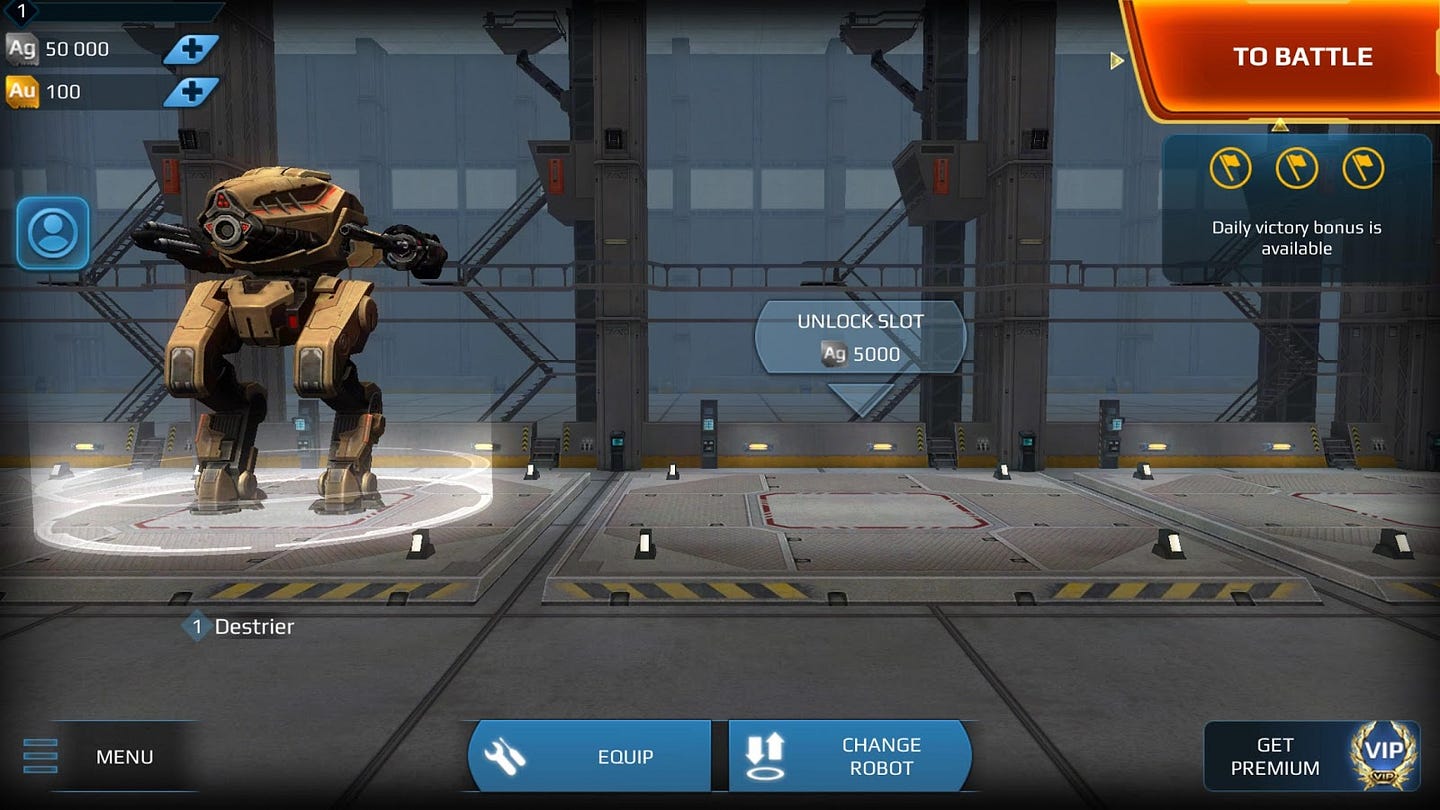
Soft Currency
The first value players meet in the game is Soft Currency – Silver, that they can earn in the battle. Some part of the silver gets spent on the repair of a damaged robot. The primary purpose of the silver is buying and upgrading robots and weapons.
The first fight on the light robot, Destrier, brings enough silver to unlock the second slot and to buy another bot. It makes it possible to present to players the central value at this stage — the number of unlocked slots. If one robot is killed in combat, the robot from the second and following slots continues the battle. The third slot costs 100 gold ($ 1) — a hard game currency that can be bought for money.
Progress
Adding slots is a “horizontal” growth while upgrading robots is the “vertical” growth. Silver four in War Robots as the primary tool for upgrading robots and weapons. The time for the upgrade rises from level to level, and, for example, the transition from the 5th to 6th level takes 8 hours. Completing the robot’s upgrade from 1st to 12th level takes 20 days. You also need to upgrade each weapon.
Most of the players in mobile games are familiar with at least one of the favorite strategies in which the continuity of the upgrade by timers is the primary driver of development. Therefore, the player of War Robots is immediately drawn into a continuous series of upgrades. This encourages them to return to the game and gives a legitimate opportunity to send out push notifications that are important to the player.
A new player can be promoted to the next league up to the silver league, even if they lost games. With each battle, the player evolves into a whirlwind of offensive defeats from strong opponents in higher leagues. More often, it is an experienced feeling of lagging behind regarding weapon power, speed, and survival.
From this state, there are two possible solutions:
1) The player buys robots and weapons for money. Robots such as Lancelot, Galahad, and Orcans immediately take the player to a new position in their league in which he is the leading player on the battlefield.
2) The player begins to experience free robots and unique combinations of weapons, which helps them become actively involved in beating current metagame.
Approximately, at the moment when a player who doesn’t want to pay understands that all this fuss won’t help him to win, the game offers a third type of game currency that allows the player to get cool robots by spending time instead of money. At the 20th level, the Workshop opens every 85 hours, and the player drips 85 points of the workshop every 4 hours.
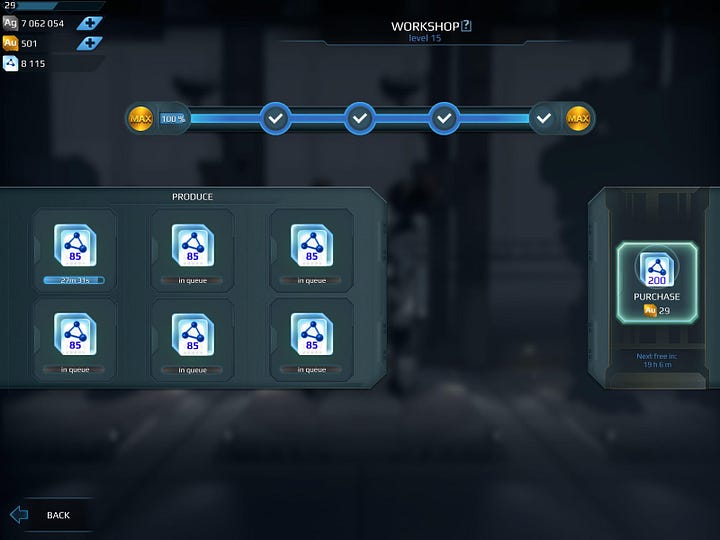
One of the best heavy robots in the game — Rhino, costs 15,000 points. It takes an entire month to go into the game every 4 hours to gain 85 points. However, the process can be accelerated. Once a day in the workshop, you can collect 40 points for free, and then convert a small amount of gold into workshop points at an effective rate of 1 to 12. With each subsequent transaction, the rate worsens on that day and reaches 1 to 1.35. As a result, the player is again unobtrusively encouraged to spend gold.
It looks like the involvement of non-paying players is essential for the War Robots ecosystem at all stages of the game. They invented a fourth game currency — Influence Points. The player can obtain this point by inviting referrals to the game. Players can spend IP to buy unique competitive robots. For example, to buy a medium robot, a DLC player must successfully bring 12 referrals.
The third and fourth game currencies act as a permanent exclusive promotion for non-paying players, which gives them the opportunity to play in top-fights, in exchange for regular visits to the game or participating in the referral program. Also, the workshop points slow down while getting all the top content for paying players.
Social
In MOBA, a team that works well together has an advantage in front of some team of random players. War Robots actively encourages players to go into fights in platoons by giving out small awards in hard game currency. In the menu, in the section where you create platoons, you can invite your friends from Facebook who has played with the player in previous battles and participants of your clan.
When you create your platoon, you should invite participants from approximately even leagues. The battle will take place in the highest player’s league. Clans help to solve this problem because, among 36 participants of a clan, you can usually find players in your league for a platoon. There is a leaderboard in the interface of the top 100 clans collected by participants action points.
MONETIZATION
Gold in War Robots doesn’t appear for players until only after they pay money into the game. We start with 100 gold on the account. Every time a player reaches the next level, he gets 50 gold. There are two daily tasks that give 30 gold each. For a successful game in a victorious battle, they offer five gold for the lead in the damage dealt, and five gold for the leading in capturing the beacons.
The stability of small hard currency earnings accustoms the player to spend and removes the psychological block for the price of gold. For 100 gold, the third slot can be bought; then we can accumulate 1000 gold for a 4th slot. The fifth slot costs 5000 gold ($ 50), and it is mandator


